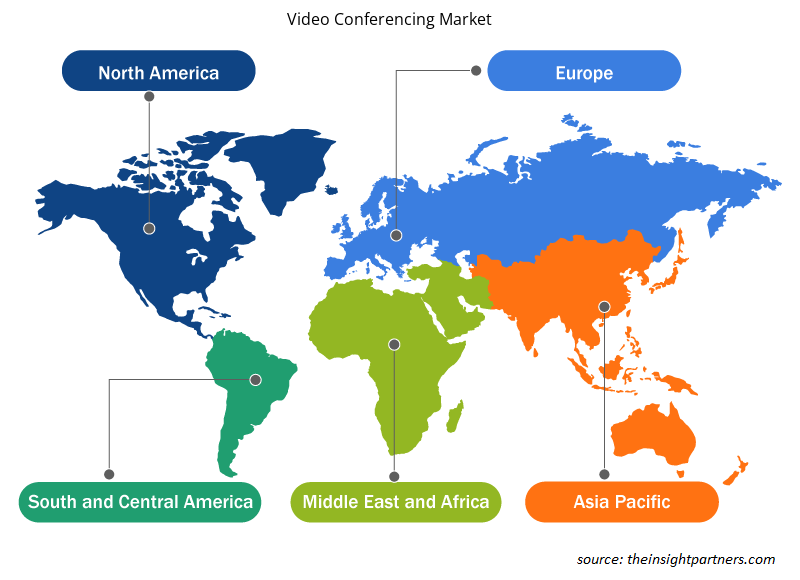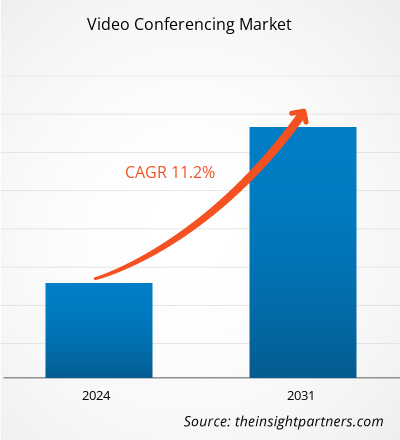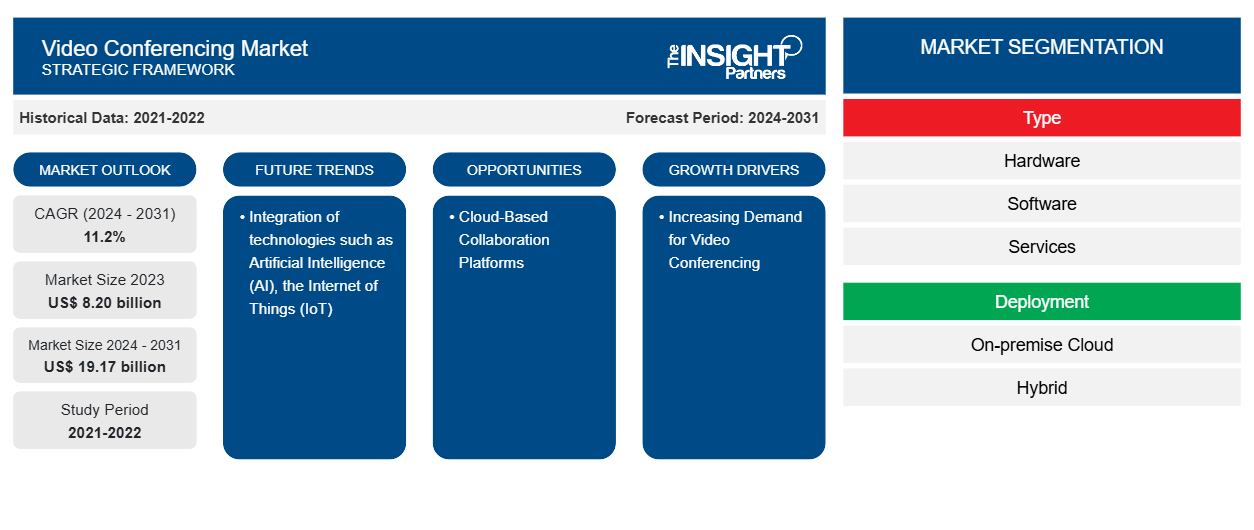Si prevede che le dimensioni del mercato globale delle videoconferenze cresceranno da 8,20 miliardi di dollari nel 2023 a 19,17 miliardi di dollari entro il 2031; si prevede che si espanderà a un CAGR dell'11,2% dal 2024 al 2031. L'integrazione di tecnologie come l'intelligenza artificiale (AI), l'Internet of Things (IoT) e la tecnologia cloud probabilmente rimarrà una tendenza chiave del mercato delle videoconferenze.
Analisi del mercato delle videoconferenze
L'aumento del lavoro da remoto e dei team virtuali ha alimentato la domanda di soluzioni di videoconferenza. La videoconferenza consente una comunicazione e una collaborazione efficaci tra team geograficamente dispersi, portando a una maggiore adozione nelle organizzazioni.
Panoramica del mercato delle videoconferenze
La videoconferenza è uno strumento potente che consente a singoli e team di connettersi e collaborare da remoto, indipendentemente dalla loro posizione fisica. Sfrutta tecnologie audio e visive per creare riunioni virtuali, consentendo ai partecipanti di comunicare in tempo reale come se fossero nella stessa stanza. Questa tecnologia ha rivoluzionato il modo in cui operano le aziende facilitando una comunicazione fluida, migliorando la produttività e promuovendo la collaborazione globale. Nel mondo frenetico degli affari, la videoconferenza è diventata uno strumento essenziale per le organizzazioni di tutte le dimensioni. Elimina le barriere della distanza e del tempo, consentendo ai professionisti di condurre riunioni faccia a faccia senza la necessità di viaggiare. Ciò non solo consente di risparmiare tempo prezioso, ma riduce anche i costi associati a trasporto, alloggio e altre spese logistiche.
Personalizza questo report in base alle tue esigenze
Riceverai la personalizzazione gratuita di qualsiasi report, comprese parti di questo report, o analisi a livello nazionale, pacchetto dati Excel, oltre a usufruire di grandi offerte e sconti per start-up e università
-
Scopri le principali tendenze di mercato in questo rapporto.Questo campione GRATUITO includerà analisi di dati che spaziano dalle tendenze di mercato alle stime e alle previsioni.
Driver e opportunità del mercato delle videoconferenze
La crescente domanda di videoconferenza favorisce il mercato
La domanda di soluzioni di videoconferenza è aumentata costantemente negli ultimi anni. Questa crescita può essere attribuita a diversi fattori, tra cui la necessità di riunioni visive in tempo reale e collaborazione tra individui e team. La tendenza emergente del lavoro da remoto e delle operazioni aziendali geograficamente distribuite ha contribuito all'aumento della domanda di soluzioni di videoconferenza. Con più persone che lavorano da casa o in luoghi diversi, la videoconferenza fornisce un modo comodo ed efficiente per connettersi e collaborare. Le soluzioni di comunicazione video consentono alle grandi aziende di migliorare la loro efficienza operativa e offrire una migliore esperienza al cliente. Queste soluzioni promuovono la collaborazione tra dipendenti situati in luoghi diversi, consentendo ai team di lavorare insieme senza problemi.
Piattaforme di collaborazione basate su cloud
Le piattaforme di collaborazione basate su cloud sono diventate sempre più popolari tra aziende e organizzazioni grazie alla loro flessibilità, scalabilità e facilità d'uso. Queste piattaforme sfruttano la tecnologia cloud per abilitare la comunicazione in tempo reale , la condivisione di documenti e la gestione dei progetti. Le piattaforme di collaborazione cloud consentono ai membri del team di collaborare e condividere idee all'istante tramite commenti in tempo reale, chat e videoconferenze. Questa flessibilità consente ai team di lavorare insieme indipendentemente dalla loro posizione fisica, rendendo più facile per i team remoti o in città diverse collaborare in modo efficace.
Analisi della segmentazione del rapporto di mercato sulla videoconferenza
Segmenti chiave che hanno contribuito alla derivazione dell'analisi del mercato delle videoconferenze: tipo, distribuzione e settore verticale.
- In base al tipo, il mercato è suddiviso in hardware, software e servizi. Il segmento hardware ha detenuto una quota di mercato maggiore nel 2023.
- In base all'implementazione, il mercato è diviso in cloud on-premise e ibrido. Il segmento on-premise ha detenuto una quota di mercato maggiore nel 2023.
- In base al settore verticale, il mercato è suddiviso in corporate enterprise, government & defense, healthcare, education, manufacturing e altri. Il segmento corporate enterprise ha detenuto una quota di mercato maggiore nel 2023.
Analisi della quota di mercato delle videoconferenze per area geografica
L'ambito geografico del report di mercato sulla videoconferenza è suddiviso principalmente in cinque regioni: Nord America, Asia Pacifico, Europa, Medio Oriente e Africa e Sud America/Sud e Centro America. Il Nord America ha dominato il mercato della videoconferenza nel 2023. La presenza di grandi parchi eolici e importanti progetti di energia solare in Nord America ha contribuito alla crescita del mercato IGBT. Gli IGBT sono utilizzati nei convertitori di potenza per sistemi di energia rinnovabile, come turbine eoliche e inverter solari.
Approfondimenti regionali sul mercato delle videoconferenze
Le tendenze regionali e i fattori che influenzano il mercato delle videoconferenze durante il periodo di previsione sono stati ampiamente spiegati dagli analisti di Insight Partners. Questa sezione discute anche i segmenti e la geografia del mercato delle videoconferenze in Nord America, Europa, Asia Pacifico, Medio Oriente e Africa e Sud e Centro America.

- Ottieni i dati specifici regionali per il mercato delle videoconferenze
Ambito del rapporto sul mercato delle videoconferenze
| Attributo del report | Dettagli |
|---|---|
| Dimensioni del mercato nel 2023 | 8,20 miliardi di dollari USA |
| Dimensioni del mercato entro il 2031 | 19,17 miliardi di dollari USA |
| CAGR globale (2024 - 2031) | 11,2% |
| Dati storici | 2021-2022 |
| Periodo di previsione | 2024-2031 |
| Segmenti coperti |
Per tipo
|
| Regioni e Paesi coperti |
America del Nord
|
| Leader di mercato e profili aziendali chiave |
|
Densità degli attori del mercato: comprendere il suo impatto sulle dinamiche aziendali
Il mercato del mercato delle videoconferenze sta crescendo rapidamente, spinto dalla crescente domanda degli utenti finali dovuta a fattori quali l'evoluzione delle preferenze dei consumatori, i progressi tecnologici e una maggiore consapevolezza dei vantaggi del prodotto. Con l'aumento della domanda, le aziende stanno ampliando le loro offerte, innovando per soddisfare le esigenze dei consumatori e capitalizzando sulle tendenze emergenti, il che alimenta ulteriormente la crescita del mercato.
La densità degli operatori di mercato si riferisce alla distribuzione di aziende o società che operano in un particolare mercato o settore. Indica quanti concorrenti (operatori di mercato) sono presenti in un dato spazio di mercato in relazione alle sue dimensioni o al valore di mercato totale.
Le principali aziende che operano nel mercato della videoconferenza sono:
- Adobe Systems Inc.
- Ingrandire
- Italiano: Avaya Inc.
- Cisco Systems Inc.
- Società per azioni Huawei Investment and Holding Co., Ltd.
Disclaimer : le aziende elencate sopra non sono classificate secondo un ordine particolare.

- Ottieni una panoramica dei principali attori del mercato delle videoconferenze
Notizie e sviluppi recenti sul mercato delle videoconferenze
Il mercato delle videoconferenze viene valutato raccogliendo dati qualitativi e quantitativi dopo la ricerca primaria e secondaria, che include importanti pubblicazioni aziendali, dati associativi e database. Di seguito è riportato un elenco degli sviluppi nel mercato:
- A marzo 2024, Google Meet ha introdotto una funzionalità di ritocco dei ritratti all'avanguardia, progettata specificamente per le riunioni virtuali. Questa funzionalità innovativa offre agli utenti la possibilità di migliorare il proprio aspetto con le impostazioni "Ritocco sottile" e "Levigatura", garantendo un aspetto professionale e raffinato. Infondendo fiducia negli utenti, questa funzionalità contribuisce a un'esperienza di riunione online fluida e professionale. È accessibile agli utenti Business Standard, Education Plus e Google Workspace Individual, consentendo loro di presentarsi nella migliore luce possibile durante le interazioni virtuali.
(Fonte: Google, Comunicato stampa, 2024)
Copertura e risultati del rapporto sul mercato delle videoconferenze
Il rapporto "Dimensioni e previsioni del mercato delle videoconferenze (2021-2031)" fornisce un'analisi dettagliata del mercato che copre le seguenti aree:
- Dimensioni e previsioni del mercato a livello globale, regionale e nazionale per tutti i segmenti di mercato chiave coperti dall'ambito
- Dinamiche di mercato come fattori trainanti, vincoli e opportunità chiave
- Principali tendenze future
- Analisi dettagliata delle cinque forze PEST/Porter e SWOT
- Analisi di mercato globale e regionale che copre le principali tendenze di mercato, i principali attori, le normative e gli sviluppi recenti del mercato
- Analisi del panorama industriale e della concorrenza che copre la concentrazione del mercato, l'analisi della mappa di calore, i principali attori e gli sviluppi recenti
- Profili aziendali dettagliati
- Analisi storica (2 anni), anno base, previsione (7 anni) con CAGR
- Analisi PEST e SWOT
- Valore/volume delle dimensioni del mercato - Globale, Regionale, Nazionale
- Industria e panorama competitivo
- Set di dati Excel
Report recenti
Testimonianze
Motivo dell'acquisto
- Processo decisionale informato
- Comprensione delle dinamiche di mercato
- Analisi competitiva
- Analisi dei clienti
- Previsioni di mercato
- Mitigazione del rischio
- Pianificazione strategica
- Giustificazione degli investimenti
- Identificazione dei mercati emergenti
- Miglioramento delle strategie di marketing
- Aumento dell'efficienza operativa
- Allineamento alle tendenze normative























 Ottieni un campione gratuito per - Mercato delle videoconferenze
Ottieni un campione gratuito per - Mercato delle videoconferenze